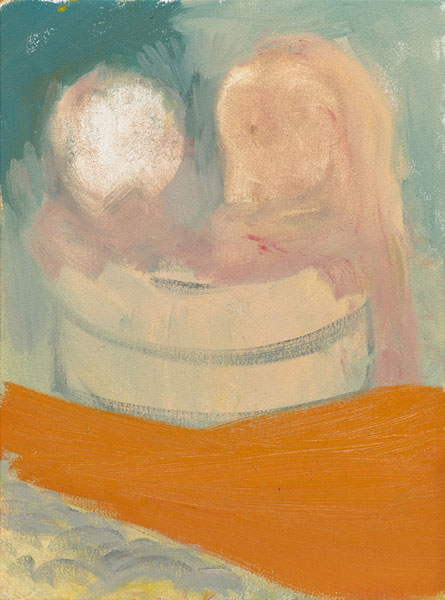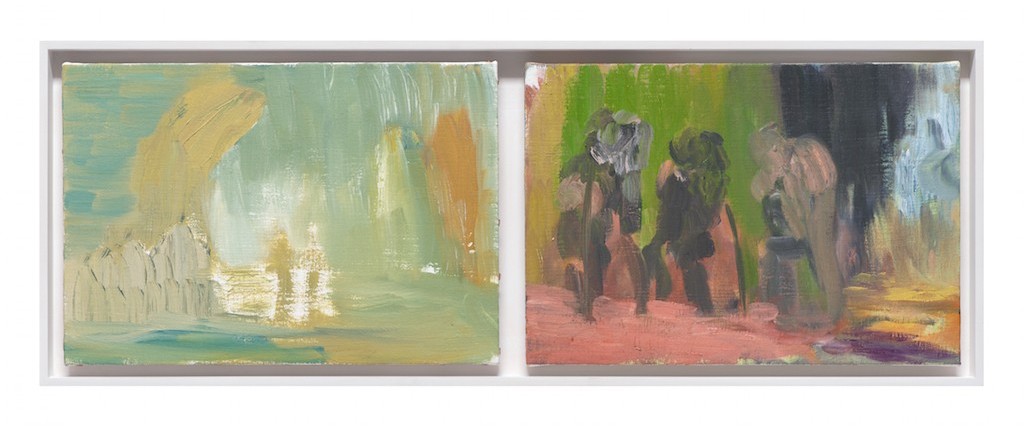
artpractical.com
May 26, 2015
Studio Sessions: Conversation with Brett Goodroad
By Claudia La Rocco
Studio Sessions offers behind-the-scenes access to Bay Area artists, writers, curators, and creative individuals through a variety of tête-à-tête conversations that consider the how, and what, and where of making art. Studio Sessions are presented as interviews, profiles, and studio visits through text, photo essays, and videos.
Brett Goodroad and Claudia La Rocco met in the summer of 2013 at Headlands Center for the Arts. He was the Tournesol Award artist, working on a solo show for the Luggage Store gallery, and she was in residence, finishing the manuscript for The Best Most Useless Dress (Badlands Unlimited, 2014), a collection of writings featuring poetry, criticism, and performance texts. They’ve subsequently undertaken a collaborative exchange of materials as a private art project, sending language, images, and other things through the mail over a period of months.
What follows here is their first public conversation. Goodroad’s current solo show, A Mended Prism: Paintings and Works on Paper, runs through May 23, 2015, at Gregory Lind Gallery, San Francisco. La Rocco, who is based in Brooklyn, is teaching at Stanford University this quarter; she is performing a 2+2 concert at the Berkeley Arts Festival with the saxophonists Phillip Greenlief and Jon Raskin and the poet Elizabeth Robinson on June 6, 2015, and reading recent work at Kiria Koula, San Francisco, on June 10, 2015.

Brett Goodroad. The Hindu and the Muslim, 2014; oil on canvas; 17 1/4 x 12 7/8 in. Courtesy of the Artist and Gregory Lind Gallery.
Claudia La Rocco (CLR): You’ve said that your paintings tell you what they’re up to after the fact—that when you’re actually painting, you aren’t thinking about layers or codes or stories, but just trying to solve the space. I think that’s similar to how I write: certainly my poetry and the new novel I’m working on, but also my more successful criticism, too.
Brett Goodroad (BG): Sometimes a painting won’t reveal itself for as long as a year, and sometimes the meaning changes after that. I can’t remember the name of the poet who told me he edited his poems continually, always rehashing or recomposing, but it resonated. The composing is the most mysterious thing, actually. Often I’ll change what seems easy to understand; I guess I need to confuse myself. Nobody loves, with a capital L, a one-night stand. I don’t, anyway.
Your work separates itself from “the” editing tradition, or at least eases away from it; it isn’t trying to stand like a statue, but is more about open-ended movement. Maybe your criticism gives you the knowledge that your poetry is free to play around with: so much knowledge about dance! When we were talking about ballet and I asked what your position was with it, you seemed terse, as in, “What a ridiculous question!” Because, of course, its language is a foundational one. Like Henri Matisse or Chaim Soutine in paint.
CLR: I’ve been thinking lately that dance in many ways taught me how to write, both in terms of individual artists—Jodi Melnick! Annie-B. Parson! Wendy Whelan!—and also the form itself. I spent so many hours looking, trying to chart what was happening in front of me in tandem with what was happening internally. That’s what criticism does, and also poetry. That external-internal jostle.
About your ballet question: I think I was flummoxed by how broad it was. And also we had been talking about it in the context of people pronouncing it dead, that tedious art canard. Certainly the field is crippled by an appalling lack of imagination right now. But that’s not about ballet itself, it’s about the culture surrounding it (although, OK, they’re not entirely separate). As a language, ballet is severe and strange and alien and gorgeous and scary and brutal. I adore it. When we were at Headlands, you disclosed how into ballet you were. Not something one hears all the time. And then the other day you said you related to ballet—something about a combination of strictness and weightlessness.
BG: Ballet, I think, is one of a number of forms I gravitate toward because of its distance from my life growing up in Montana (I was and am a working-class artist). But more than that and to your point, there is an elegance in achievement in ballet: all those years, all that context, the work and the rules and the concrete belief systems brought about by previous brilliance. Ballet hovers for me, like lines in a painting, the lines that don’t need anything. They’re made simple and elegant through years of practice. Great painting is almost always this way, an easy knowing.
CLR: Lines and hovering. Now I’m thinking of Agnes Martin. Her work takes up a lot of space in my head. And thinking of her makes me think of the great little show your Tournesol successor Teresa Baker has up now at Interface Gallery in Oakland, with Jaimie Healy. Her marriage of form and content is playful and subversive and full of hidden meanings.
BG: I love that Teresa asks me to pay attention. We Tournesolees are a perfect mix of difference and conviction.
I remember when we were at Headlands and you had written all over the wall. There is a man in the Bayview district of San Francisco who writes in chalk all over the sidewalks, and none of it makes sense. Is it crazy to write on a wall and have it make sense?
CLR: I guess I don’t know why it would be crazy to write on a wall and have it make sense (though your question doesn’t surprise me, as I typically, and happily, understand about a tenth of what you write in your emails to me). Wall writing reminds me of that great weirdo performance you did at the Luggage Store in 2013, how romantic and cynical you were, squeezing that expensive paint all over the place. I remember you had on a white poet’s blouse. That seemed like the opposite of an easy knowing.
BG: Yes, that performance was a kind of spiritual exercise or excision. I don’t think I can regard spirituality of any kind without violence. John Keats and red paint. And Romanticism is religion, and religion, well...
Speaking of Interface, Carrie Hott’s exhibition there earlier this year was fantastic. Her After-Hour installation was like a hundred evenings in one room. Lamps imagined and real.

Brett Goodroad. A Sequence in Love, 2014; oil on linen; 11 1/4 x 31 in. (overall, framed). Courtesy of the Artist and Gregory Lind Gallery.
CLR: Lamps imagined and real: I might have to steal (uh, repurpose) that for something. Speaking of, I was delighted to learn that one of the works in your show at Gregory Lind takes its title from Virginia Woolf’s Orlando, which is a favorite book of mine. I was also tickled to see one of Don Voisine’s images behind Gregory’s desk. My press just published Don in I DON’T POEM: An Anthology of Painters, a collection I edited that pairs original writings with visual works by artists who mostly don’t have public writing practices. “I don’t poem” was Don’s retort when I first asked him to contribute. Somehow your “working-class artist” line makes me think of him. His paintings thrill me: the movement in them! Don and I both grew up in Maine, which has certain similarities with Montana. Being surrounded by trees and rocks and ocean had a big influence on my art, and I see that influence in his work, too.
And you? Who’s taking up space in your head these days?
BG: Laura Moriarty, Norma Cole, and Steven Seidenberg are all amazing friends and poets who are reading in so many places, I can’t keep up. Laura just wrote a piece about Norma’s show at Margaret Tedesco’s [ 2nd floor projects]. The history encased in this and Norma’s visual work is beyond my words.
I look forward to your reading at Kiria Koula in San Francisco, especially if you read from your handwritten pieces in your book. I really think that is the best form for your work. The dance. When we were collaborating via mail, they just landed. Then I threw the banana peel. Lady of Purity was the title. She was one of three ladies to dance around Orlando, each being a lie: purity, chastity, modesty. Then “the truth” is trumpeted and they flee and Orlando wakes, having transformed into a woman. I found all of it ridiculous and beautiful. Virginia Woolf really knows how to seduce.
CLR: Does she ever. Art seduction is the best.
I keep thinking of that thick slab of orange in your painting A Muslim and a Hindu (2014). All of the information in it. The tension (or is it the opposite of tension?) between solving space and telling stories. It gave me pause at first that the two thematic explorations you mentioned within your paintings in this show were illness and religion. But then, of course, you dealt with both a lot growing up.
You know, I have never read the handwritten pieces in public. It never occurred to me to do that, as I’ve always thought of them as images. But yes! I will try it. Collaborating with musicians recently (another Headlands gift, meeting Phillip Greenlief there) has begun opening me up to different ways that text can behave off the page.
Do you know the banana peel is still in my freezer? I think that was the final salvo in the exchange project we developed after Headlands. It just felt like... where else could one go from there? The refuse got the last word.
BG: I think my childhood constitutes a large part of the narrative that fills my subconscious. It’s not like I conceptualize it. I make the paintings and see illness and religion. I see that I am trying to heal something through my process, and that the solving is a part of this. I see sentimentalism, too. I usually (always) wish I’d made different work. I go through a process of trying to make the work sane. Some part of me actually wishes to tell stories like Samuel Richardson did, but it ends up like Ibsen. I want to handle color like Ingres and end up in the Nabis. I can render, but I can’t rest in the mysticism of representation. I have convictions in both camps. I guess I don’t mind if I seem vague or vacillate. I think a feeling person wishes to touch many aspects of life.
Do you know the Kafka story “A Hunger Artist” (1922)? Claudio Magris wrote that it was a “parable of a perfection which sterilizes life.” I wish one of my paintings could be as good as that story. But all I can do is suggest. And oftentimes the works do resemble parables.
